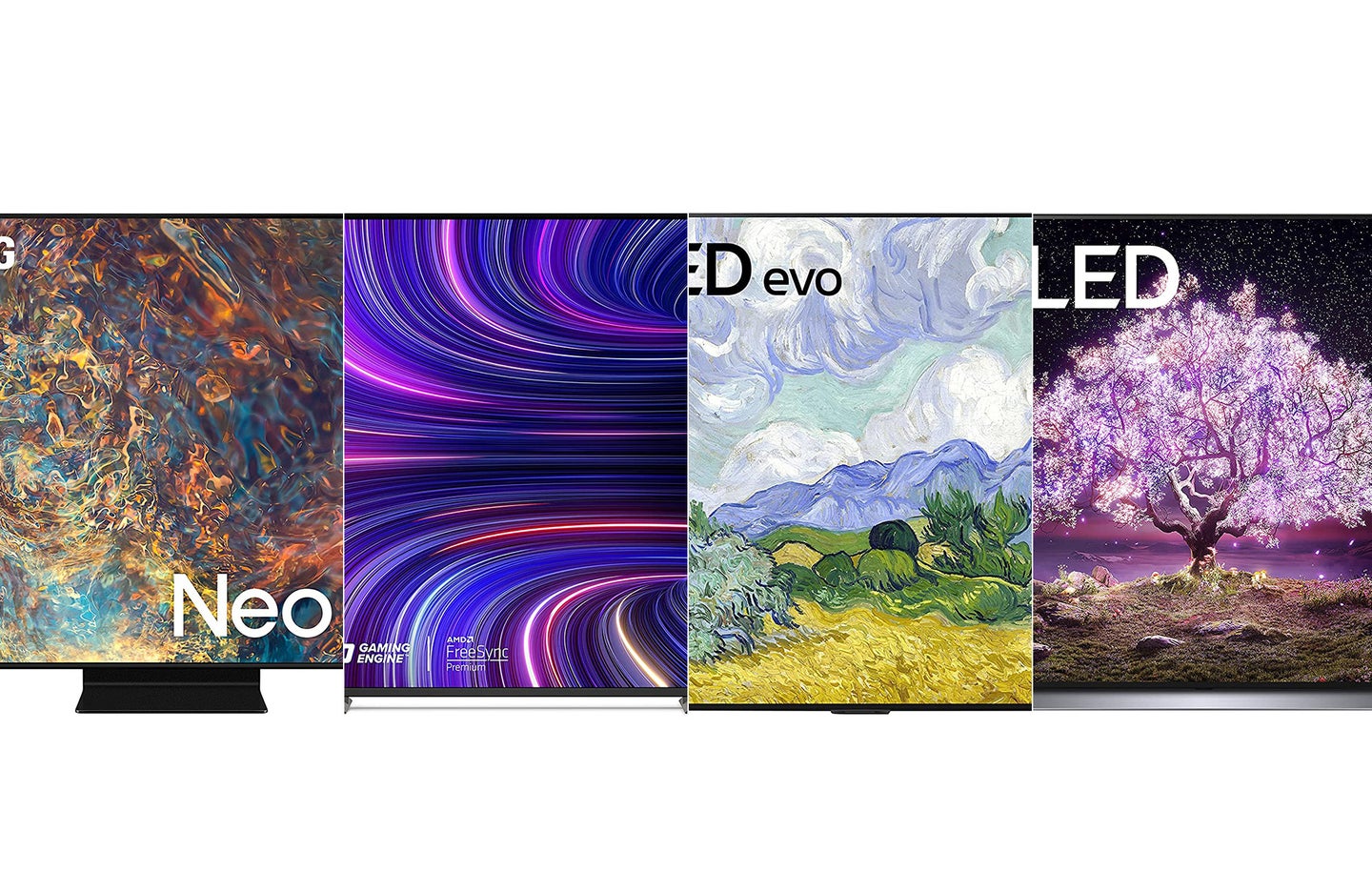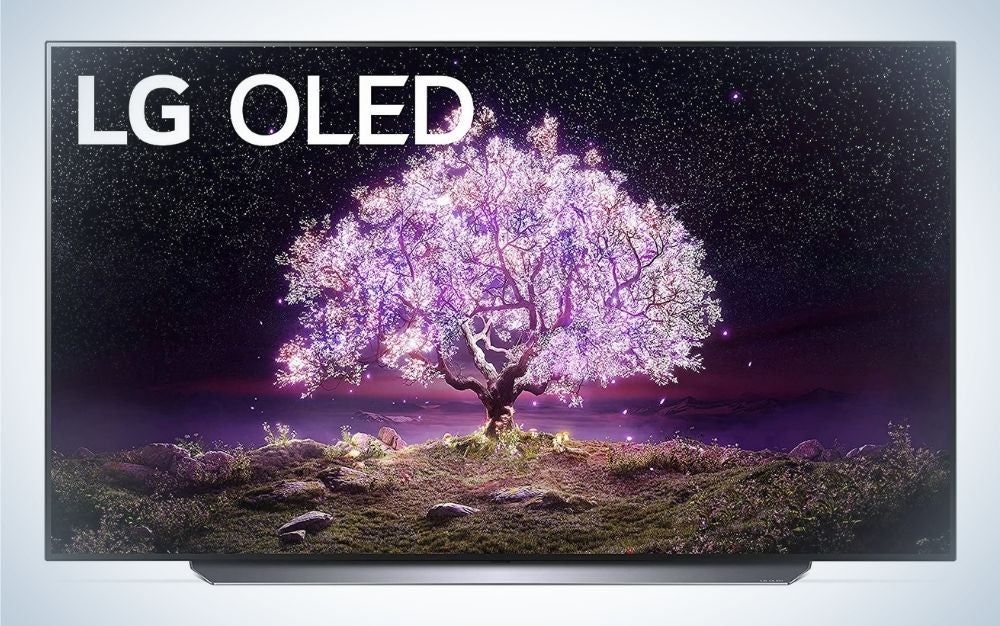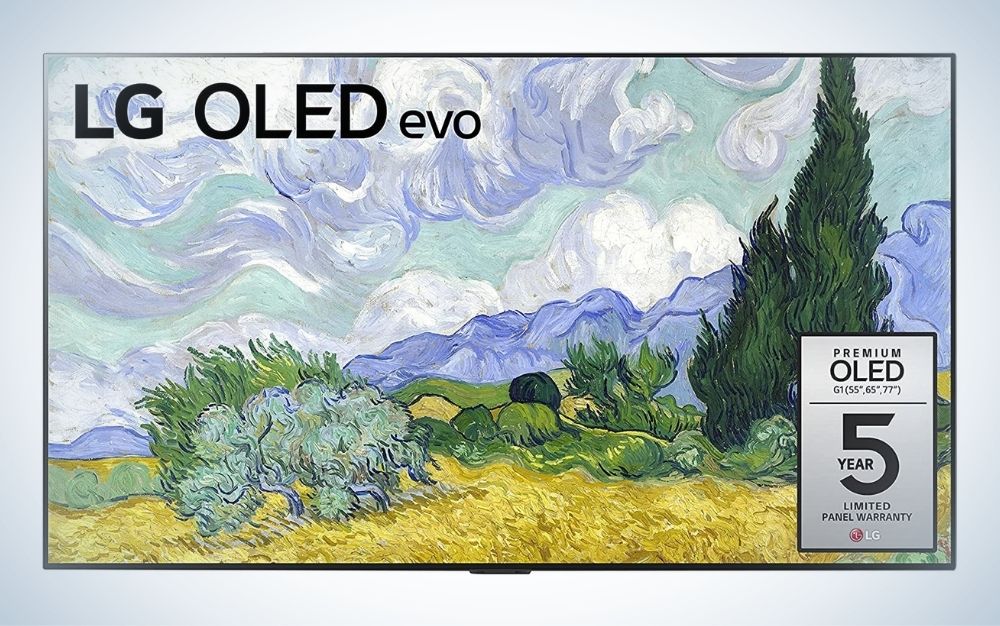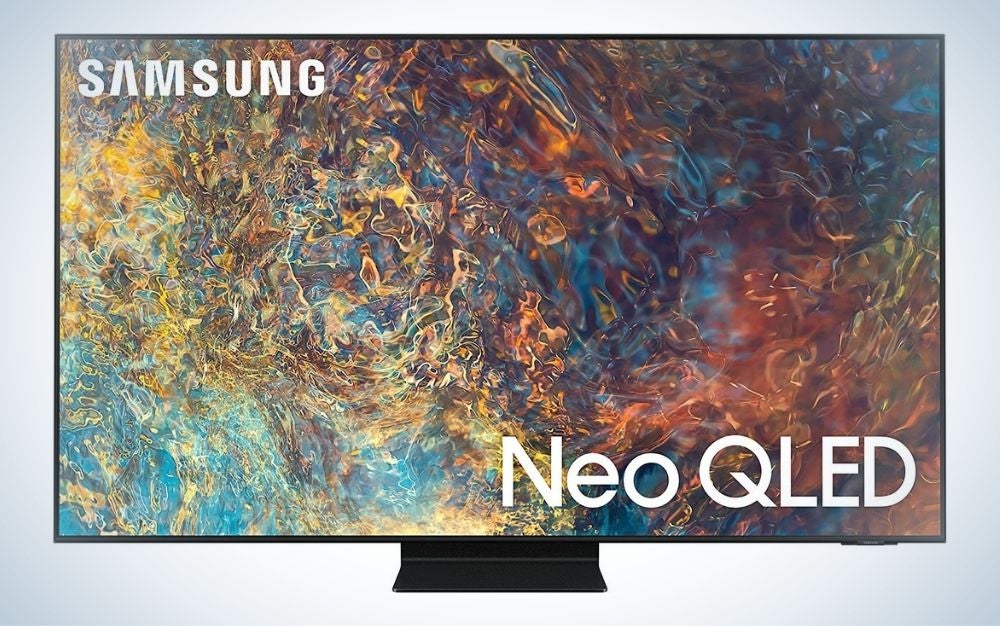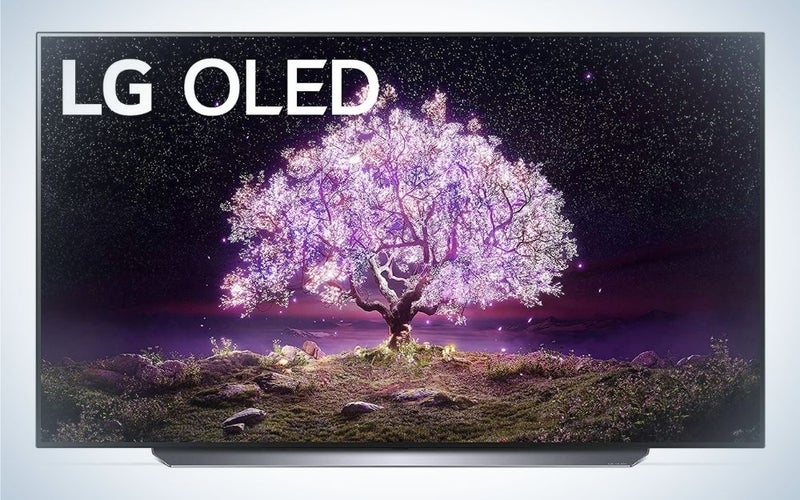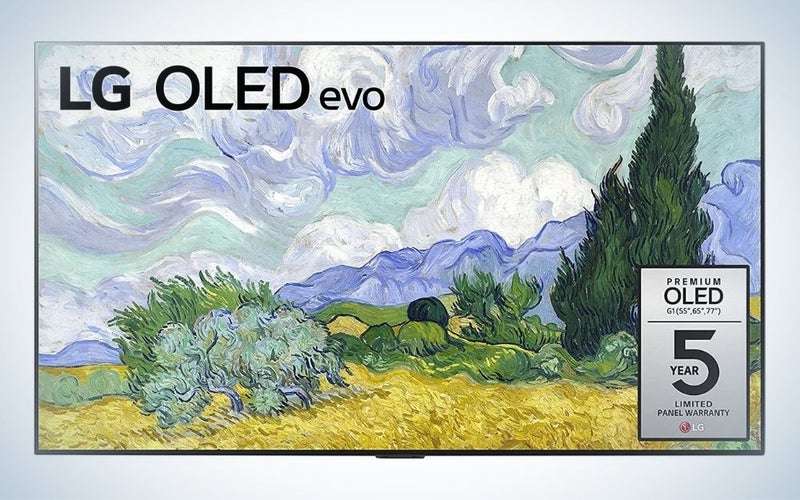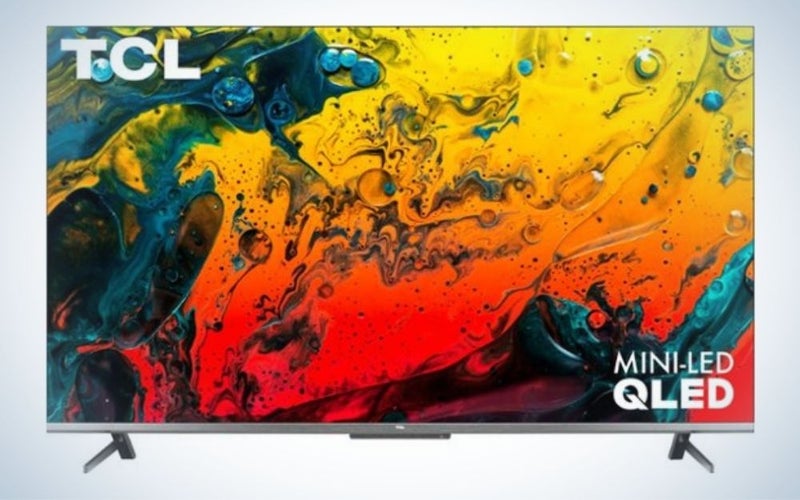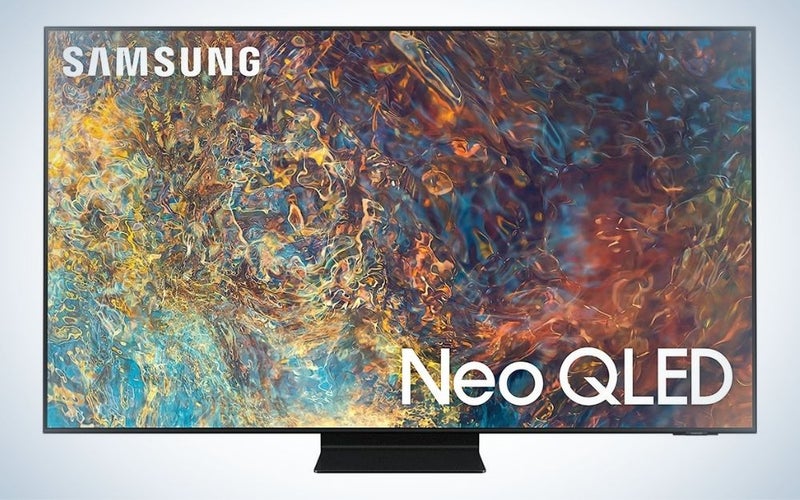We may earn revenue from the products available on this page and participate in affiliate programs. Learn more ›
If you’re looking for an immersive TV-watching experience, you’ve come to the right place. A 75-inch TV can transform your home theater setup with a bigger, brighter, and better picture. The bigger the TV, though, the higher the stakes. If you’re going to spend thousands of dollars on a big big screen, you want to make sure you’re getting something great. Meanwhile, there are fewer models up in the XL TV space, so you may wind up looking at models you might not have otherwise. That said, our picks for the best 75-inch TVs are all killer models, so there’s something out there for everyone.
- Best overall: LG C1
- Best OLED: LG G1
- Best budget: TCL 6-Series Google TV (R646)
- Bestfor gaming: Vizio P-Series
- Best QLED: Samsung QN90A
How we picked the best 75-inch TVs
I’ve covered consumer electronics for more than 10 years for sites like TechnoBuffalo, XDA Developers, and iMore. During that time I’ve seen my fair share of TVs—especially when browsing the halls at CES, where TV displays go on for what feels like miles. I love to escape into a good movie, so finding the right TV is a big deal to me.
While searching for the best 75-inch TVs, I considered the essential elements of picking any television, including technology that goes into the actual display panel, picture quality, features, and price. We also looked at each model’s built-in Smart TV features, although I think you’re better off using a separate streaming device, which often provides faster, smoother access to your streaming apps. If it affects how your TV and movies will look, I scoped it out.
Things to consider before buying a 75-inch TV
Buying a TV this large requires a little prep and a little planning. While we tend to assume that bigger is always better, you should make sure you figure out where you plan to put a 75-inch TV and make sure you have enough room to accommodate it before bringing one home. Sitting too close to a large screen could lead to a lousy viewing experience. Even worse, you could experience neck and eye strain. Nobody likes to sit in the front row at the movie theater, so don’t create that environment for yourself at home. This distance calculator says you should sit 10-and-a-half feet away from a 75-inch TV for the best viewing experience.
Once you know you have enough room to handle a 75-inch TV, you have to pick one. There’s very little difference between picking a larger TV vs more standard sizes like the best 55-inch TVs and best 65-inch TVs. You are, however, hampered slightly by the limited range of models that reach this size. Many of our top picks are still in play, though, so it’s far from a compromise.
QLED vs OLED
There are two advanced panel technologies found in modern high-end TVs: Quantum Dot Light-Emitting Diode, or QLED, and Organic Light-Emitting Diode, or OLED. Since size determines price more than any other factor, most of your options for a 75-inch TV are quite luxurious, which means they’ll likely feature one of these two technologies.
The QLED display riffs on traditional LED-backlit LCD panel design, adding an additional layer of transmissive “quantum dots” in the screen that enhances the display’s color, brightness, and contrast. Separately, many high-end QLED TVs feature Mini-LED backlighting. This can adjust the brightness for different parts of the screen independently to enhance the panel’s contrast. When you put these two features together, you get an extremely bright, rich picture. Because it is based on existing display tech, there tend to be more affordable QLED options … though you may not notice when picking a TV this size.
Critics and analysts love to talk about OLED screens, though. Unlike QLED, OLED is an entirely new technology. In an OLED display, independently controlled LEDs illuminate each pixel on the screen. Because they operate independently, the TV can turn off individual pixels to display “true blacks,” without any light bleeding through. (TVs with older LED technology have a tendency to “spill” light into shadows, lightly muddling picture quality.)
The general consensus among experts—ourselves included—is that the elite OLED screens produce the best picture under ideal conditions. QLED comes close, though, and may work better for TVs in a room where direct sunlight might cause glare. For a more detailed explanation of the different panel technologies, check out the explainers in our selections of the best OLED TVs and best QLED TVs.
Resolution
Content in 4K resolution, or 3840 x 2160p, is more widely available than ever through streaming services and game consoles. If you’re stepping up to a 75-inch TV, 4K is where you want to be. Images displayed on a larger screen will look sharper and pixels won’t be nearly as noticeable compared to if you were watching content on a Full HD (1080p) TV of similar size.
While you can go all-out and buy an 8K TV, we generally don’t recommend it. There is very little content to watch, which means you won’t be able to take advantage of that extra resolution. The best reason to purchase an 8K TV right now is to prepare you for the future. However, we expect that new technologies may hamstring today’s 8K TVs by the time there’s enough content to make one a worthwhile purchase.
Refresh rate
Refresh rate refers to the number of times your TV can “draw” an image on screen each second. It’s been a core feature on computer monitors for a long time but has only become a hot new feature on TVs in the last 2-3 years. Until recently, TVs always stuck to a 60Hz refresh rate, which is fine for movies and TV. Some modern sets have started supporting a higher 120Hz refresh rate, specifically with gaming in mind. The Xbox Series X and PlayStation 5 both offer titles that can run games at a 120Hz frame rate, animating more smoothly. A higher refresh rate can also do wonders for live sports, which also look smoother at a higher frame rate.
Some TVs also support variable refresh rate, a technology that allows your TV to sync its refresh rate with the device sending it an image—most likely a PC or game console. It makes both devices more efficient, resulting in smoother gameplay and fewer visual hiccups, such as stuttering and screen tearing. Many TVs support one or both of the variable refresh rate standards created for PC gaming, AMD FreeSync and Nvidia G-Sync. Some, however, feature a proprietary version. We generally recommend looking for AMD FreeSync for console gamers, or whatever standard pairs best with your PC.
Both 4K/120Hz support and variable refresh rate are only enabled when your TV and devices are connected using HDMI 2.1, the newest version of the HDMI standard. Modern TVs typically include both HDMI 2.0 and HDMI 2.1 ports, so make sure to check how many of each you’ll get before making a purchase (and get appropriately compatible HDMI cables).
Smart TV features
Most modern TVs feature some kind of Smart TV hub, giving users easy access to streaming apps like Netflix, Hulu, HBO Max, and more. While there are a couple of licensed operating systems, like Roku TV and Google TV, most TV manufacturers make their own smart TV hub. The nice thing about having Smart TV features built in is you can start streaming right away, and your HDMI ports are free for other devices. The not-so-nice thing is that many smart TV systems are slow, and feature a comparatively limited library of apps. We generally recommend using a dedicated streaming device, or a popular piece of electronics with streaming app support, like a game console.
The best 75-inch TVs: Reviews & Recommendations
At 75 inches, the TVs aren’t just bigger—they’re a lot more expensive. If you’ve been looking at TVs in small sizes, prepare for some sticker shock. That’s all the more reason to do your due diligence and make sure the TV you buy can do everything you need it to. We think that these picks, the best 75-inch TVs, have something for everyone.
Best overall: LG C1
LG
Why it made the cut: The LG C1 has been a longtime favorite and continues to be a showcase for the company’s OLED technology.
Specs
- Size: 77”
- Display: OLED 4K
- Refresh rate: 120Hz
- Ports: HDMI 2.1 x 4, USB 2.0 x 3, Ethernet, Bluetooth
Pros
- Sharp, vibrant picture
- 4K/120Hz support
- Four HDMI 2.1 ports
Cons
- OLED panel could be brighter
The LG C1 is a longtime favorite of ours, and consistently beloved across the industry by consumers and reviewers. LG’s OLED displays look gorgeous at 55 inches and 65 inches, so you won’t be shocked to hear the 77-inch model looks good, too. The C1’s beauty is more than skin deep, though: It comes equipped with a plethora of next-generation features, including support for features like 4K resolution at 120Hz, G-Sync and FreeSync variable refresh rate, and auto-low-latency mode. It also features Cinema HDR (Dolby Vision, HDR10, HLG) and 4K upscaling, the latter of which artificially enhances lower resolution content.
It’s worth pointing out that LG recently released its successor to the C1, the LG C2 Evo. Some very positive reviews are starting to come in, but our team hasn’t tested the TV yet, so we’re withholding judgment until we can take a closer look. In the meantime, many retailers have slashed prices on the C1, making it a great time to save a little cash on an incredible TV.
Best OLED: LG G1
LG
Why it made the cut: The LG G1 ups the stakes with a sleek design and a fantastic OLED panel.
Specs
- Size: 77”
- Display: OLED 4K
- Refresh rate: 120Hz
- Ports: HDMI 2.1 x 4, USB 2.0 x 3, Ethernet, Bluetooth
Pros
- Four HDMI 2.1 ports
- 4K 120Hz
- Beautiful, minimal design
Cons
- Expensive
Technically, the LG G1 is the higher-end version of our top pick, the LG C1. It offers the same fantastic OLED display in a sleek design that can be mounted flush with a wall. That, along with a minimalist design, makes the G1 a “lifestyle” TV, designed to blend in with your home’s decor when it isn’t in use. Like Samsung’s The Frame TV, it features a “gallery mode” where the screen cycles through LG’s library of classic artwork. Like the C1, it features the newest gaming-focused features, including 4K/120Hz support, variable refresh rate, and four HDMI 2.1 ports.
We usually recommend the LG C1 over the G1 since the two offer very similar picture quality, but the C1 costs substantially less. At $3,299.99, the G1 is brighter but the $2,699.99 C1 is undoubtedly a better deal. If you’re willing to set the concept of value aside and reach for the best possible screen quality, the G1 is the move.
That said, like the C1 and C2 Evo, LG recently released a new version of the G1 called the LG G2 Evo. LG said the G2 will offer a brighter OLED panel than the G1, which could make it the best-of-the-best choice. We’ll reserve judgment until we can see the G2 with our own eyes.
Best budget: TCL 6-Series (R646)
TCL
Why it made the cut: TCL’s 6-Series is an incredible value at any size, but it’s truly a steal at 75 inches.
Specs
- Size: 75”
- Display: QLED 4K
- Refresh rate: 120Hz
- Ports: HDMI 2.1 x 3, USB 2.0 x 2, Ethernet, Bluetooth
Pros
- Mini-LED QLED 4K display
- Three HDMI 2.1 ports
- 4K 120Hz
- Affordable
Cons
- TCL makes three “6-Series” TVs, which can get confusing
TCL’s 6-Series 75-inch TV features a Mini-LED QLED 4K display, HDR, built-in Chromecast, and Google TV—all for under $2,000. The 6-Series would be a strong contender, even at a higher price: While it isn’t LG OLED-perfect, it produces a bright, sharp picture that’s worth staring at. The quantum dot panel and Mini-LED backlighting get nice and bright. HDR content stands out and the picture is saturated with rich colors, providing viewers with a wonderful experience. It also features many of the specialty features we look for in a TV, including 4K/120Hz support.
One thing to keep in mind if this TV strikes your fancy. TCL actually makes three “6-Series” TVs: one with the Roku TV operating system, one with Google TV, and an 8K model. All things being equal, we recommend the Best Buy-exclusive Google TV-based model, which comes with features the Roku version doesn’t, including two HDMI 2.1 ports.
Best for gaming: Vizio P-Series
VIZIO
Why it made the cut: The Vizio P-Series features a Quantum Color 4K LED display, HDMI 2.1, and support for the best next-generation gaming features.
Specs
- Size: 75”
- Display: QLED 4K
- Refresh rate: 120Hz
- Ports: HDMI 2.1 x 4, USB 2.0, Ethernet, Bluetooth
Pros
- Affordable
- Bright, beautiful 4K display
- HDMI 2.1
Cons
- So-so viewing angles
As a gaming TV, the Vizio P-Series ticks all the right boxes. Its bright 4K display generates a sharp picture that displays nice contrast and accurate colors. Like many options on this list, it supports Dolby Vision HDR and refresh rate-focused features, including AMD FreeSync. It also offers full array local dimming and a peak brightness of 1200 nits, ensuring a strong HDR experience. Like all good gaming TVs, the P-Series includes a mode that’s specifically designed for gaming. With gaming mode turned on, you get quick access to gaming-related features right at your fingertips. That’s much better than being forced to dive into complicated settings.
While pretty much every pick on this list is excellent for gaming, the Vizio P-Series gets special props for compiling most of the features you want in a less expensive, sub-$2,000 package.
Best QLED: Samsung QN90A
Samsung
Why it made the cut: The Samsung QN90A delivers the best picture quality you can get on a QLED TV.
Specs
- Size: 75”
- Display: QLED 4K
- Refresh rate: 120Hz
- Ports: HDMI 2.1, HDMI 2.0 x 3, USB 2.0 x 2, Ethernet, Bluetooth
Pros
- Gorgeous design
- Game-specific enhancements
- Ultra viewing angle
Cons
- Only one HDMI 2.1 port
At the highest levels, Samsung’s bread-and-butter is QLED, a display technology it invented. The Samsung QN90A shows off exactly what the company can do with it.
The Mini-LED backlit QLED TV features local dimming, resulting in an exceptionally bright picture you can’t get from OLED screens. It doesn’t skimp on features either, including 4K/120Hz support and an “ultra viewing angle” mode promising a good viewing experience even when you’re not looking at the TV head-on. Additionally, the QN90A features auto low latency, AMD FreeSync, and a Filmmaker Mode, which produces what the TV thinks is the most accurate image.
Like the LG TVs, Samsung has a new wave of QLED TVs in stores, including a QN90B to replace the QN90A. We’ve had very limited access to Samsung’s 2022 line, so we’re withholding judgment until we can test them properly.
FAQs
Q: Is a 75-inch TV too big?
That depends, dear reader, on where you plan to put said TV. A giant TV can provide a more immersive, thrilling home theater experience. It can also hurt the experience (and your eyes) if you don’t have room for it and sit too close. According to the RTing viewing distance calculator, you should sit 10.5 feet away from a 75-inch TV. These calculators are approximate, and there’s some merit to sitting a little closer, but if you can’t put at least 9-9.5 feet between your couch and TV, then 75 inches is too big. Having a big screen is nice, but you have to be realistic about the space the TV will occupy.
Q: What size room do I need for a 75-inch TV?
You should be able to put 10.5 feet between your couch and the TV, which means you’ll need a fairly large living room or den. The exact square footage of what will and won’t work may vary depending on your furniture and how you otherwise want to arrange your living space.
If a 10.5-foot viewing gap seems out of reach, we recommend dropping down to whatever size makes the most sense for your home. You can find the right size for you using this viewing distance calculator. We have separate lists for the best 55-inch TV and best 65-inch TVs, once you’ve settled on a size that seems right.
Q: How high should I mount my TV?
Ideally, your TV should sit so that the center of the screen sits at eye level. This ensures the most comfortable viewing experience. If you mount your TV too high, craning your neck to look at it for an extended period of time can cause neck strain. To make sure you set it up correctly, we recommend taping an outline on your wall and staring at it from your couch to find your personal sweet spot.
If you must mount your TV higher than eye level, we recommend using a tiltable mount so you can adjust the screen to find the best possible viewing angle.
Final thoughts on the best 75-inch TVs
A 75-inch TV is an incredible way to upgrade your home setup. It gets you closer than ever to a theater-like experience at home. There are many excellent options in this size range and brand-new 2022 models are starting to hit this spring. That means you will get the latest and greatest in panel technology, connectivity, and design. Who doesn’t want a larger TV to watch movies and play video games?
That said, don’t forget that TVs this large require substantial space, not to mention substantial money. If you can make it work, then we recommend taking the leap. There’s nothing wrong, however, with acknowledging that you’ll get more out of a smaller TV that’s technically a better fit.
